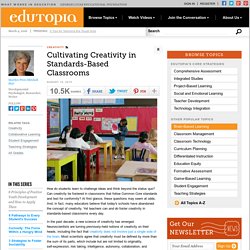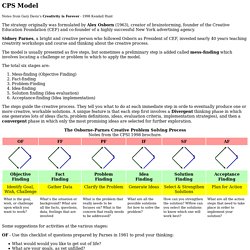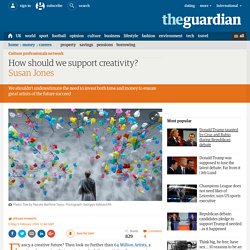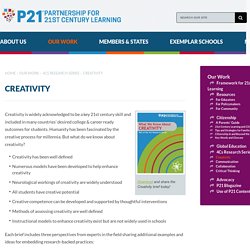

7 paths to creative classrooms. How to turn your classroom into a hotbed of creativity and innovation. Classrooms do not promote nearly enough creativity and innovation.

Here’s how they can start Ed. note: Innovation In Action is a monthly column from the International Society of Technology in Education focused on exemplary practices in education. Establishing a classroom that guides and supports students in developing their abilities to innovate and create is not often covered in teacher education or in-service professional development. Nor does learning about creativity or the skills that are drawn on in the creative act figure strongly in commonly implemented curricula or standards. On the other hand, our society looks to innovation and creativity as essential avenues that will contribute to its future prosperity and well being.
True, vestiges of arts education remain in some schools. Cultivating Creativity in Standards-Based Classrooms. How do students learn to challenge ideas and think beyond the status quo?

Can creativity be fostered in classrooms that follow Common Core standards and test for conformity? At first glance, these questions may seem at odds. And, in fact, many educators believe that today's schools have abandoned the concept of creativity. Yet teachers can and do foster creativity in standards-based classrooms every day. In the past decade, a new science of creativity has emerged. The Epicenter of Exploration and Discovery. Where Are You on the Choice Spectrum? Magazine / Where Are You on the Choice Spectrum?

Participants in our Choice Based Art Education class walk through three really important processes. Discovering where they stand today on the “Choice Spectrum.”Making a strategic decision about where they’d like to stand on the spectrum or what colors they would mix.Planning the process of reaching that goal in a way that fits their style, their school, and their students. Even if you can’t join us for the class, I wanted you to take a peek at the brand new AOE Choice Spectrum.
Fuel Creativity in the Classroom With Divergent Thinking. Recently, I showed a group of students in my high school art class a film called Ma Vie En Rose (My Life in Pink), about a seven-year-old boy named Ludovic who identifies as female.

Ludovic has an active imagination, but is bullied by both adults and other kids who are unnerved by his desire to wear dresses and play with dolls. The film challenged my students to broaden their understanding of gender and identity and led to a discussion about ways in which our imaginations are limited when we are forced to be who we are not. It also reminded me of other examples in which character is forced to choose an identity, such as the movie Divergent, based on the popular trilogy of novels by Veronica Roth.
CPS (Creative Problem Solving) model. Notes from Gary Davis's Creativity is Forever - 1998 Kendall Hunt The strategy originally was formulated by Alex Osborn (1963), creator of brainstorming, founder of the Creative Education Foundation (CEF) and co-founder of a highly successful New York advertising agency.

Sidney Parnes, a bright and creative person who followed Osborn as President of CEF, invested nearly 40 years teaching creativity workshops and course and thinking about the creative process. The model is usually presented as five steps, but sometimes a preliminary step is added called mess-finding which involves locating a challenge or problem to which to apply the model. The total six stages are: Mess-finding (Objective Finding) Fact-finding Problem-Finding Idea-finding Solution finding (Idea evaluation) Acceptance-finding (Idea implementation) The steps guide the creative process. The Osborne-Parnes Creative Problem Solving Process Notes from the CPSI 1998 brochure. Some suggestions for activities at the various stages: Torrance Incubation Model (TIM) How should we support creativity? Fancy a creative future?

Then look no further than 64 Million Artists, a national campaign that wants to unlock the creativity of everyone in Britain. Throughout January it set short daily creative challenges up to 20 minutes long that were “designed to fit into your day and bring it to life, making you more aware of your surroundings, introducing you to new places and people”. There’s also the BBC’s Get Creative scheme, which was launched last year through a series of localised debates. An example of its impact is profiled in one person’s year-long experience of trying her hand at everything from ballet to watercolours. Nowt wrong with that. The motives of initiatives such as 64 Million Artists are admirable.
CPS (Creative Problem Solving) model. Creating a Culture of Creativity, Risk-Taking and Innovation. School leaders are the architects of the social, emotional and intellectual organization of the school.

They weave different human and material resources into a significant cultural tapestry (Deal & Peterson, 2009), which incorporates individual strengths and commitments into a collective and collaborative whole and provides a platform for effective discourse and eventually, improvements, to take place. Promoting and cultivating healthy individual and collective learning and achievement cultures in schools is essential to how teachers feel about their work and how they think about themselves as professionals.
The extent to which they are able to find continuing professional and personal fulfillment through their work, and through these, sustain their commitment to teach to their best over time, will depend to a large extent upon the opportunities they have to grow, sustain and renew their capacities to be resilient (Day & Gu, 2014). Effective teams: Ineffective teams: References Deal, T. Ken Robinson: Do schools kill creativity? Educational Leadership:Creativity Now!:Learning from Creative Teachers. Creativity. We are at a unique place in time where the rapidly changing economy will open unprecedented opportunities for students.

Fueled by technology, the status quo in global education and business is being challenged. The ability to design the future and to imagine new ways of combining old with new will be game-changing skills for students. How to encourage creativity in the classroom. More and more teachers are talking about it, but how can you help students become creative?

IB World magazine asks educators for their tried-and-tested methods Passing exams is important, but it should never be the sole focus of a student’s school years. Educating a child today involves not only teaching them worthwhile facts and figures, but also providing them with the skills they’ll need to enjoy a rich and successful life, whether that means preparing them for the unpredictable workforce of the future or just empowering them with the ability to solve any problems they may encounter. Four Ways to Create a Culture of Innovation - EdTech Researcher. Creating the Conditions for Innovative Teaching and Learning – A.J. JULIANI. Last weekend, as we were digging out of the twenty inches of snow, my kids were sledding in the backyard and hiding out in their igloo.

My 4-yr old son had another snow day passion, filling up a plastic cup with snow to the brim and walking around calling it his “snow cone.” He wouldn’t go anywhere without his snow cone. I yelled to him, “Hey buddy, save some for the rest of us!” He turned around, looked across the backyard and laughed. “There’s enough for everyone”, he said. Why Creativity in the Classroom Matters More Than Ever. Image via Flickr by Linus Bohman In his popular TED talk, Ken Robinson made the powerful point that most of the students doing work in your classrooms today will be entering a job force that none of you can visualize.
That talk is from almost ten years ago, so we already know he was right and can only assume he’ll continue to be so in the years to come. Learning a specific skill set doesn’t have the value in today’s world that it once did. Learning how to be more creative (and thus adaptable) – now that’s what prepares students for life beyond the classroom. Schools and businesses throughout the world are latching onto this idea. But this trend toward valuing creativity goes beyond the big tech companies that have long treated “innovation” as a buzzword. Creativity Becomes an Academic Discipline. Photo IT BOTHERS MATTHEW LAHUE and it surely bothers you: enter a public restroom and the stall lock is broken. Fortunately, Mr. Lahue has a solution.
It’s called the Bathroom Bodyguard. Standing before his Buffalo State College classmates and professor, Cyndi Burnett, Mr. Building a Culture of Creativity. Creativity is an important element for the Gifted Classroom. Creativity on the Run: 18 Apps that Support the Creative Process. "The intuitive mind is a sacred gift, the rational mind is a faithful servant.
We have created a society that honors the servant and has forgotten the gift. " - Albert Einstein We do not need to teach creativity, but rather inspire its daily practice. Odyssey Angels Inspiration. Where the story started. . . A group of middle school students on an Odyssey of the Mind team from the Burton School District in California has been receiving accolades for combining its creative problem solving skills with public service. Over the past years, they've helped numerous friends and classmates overcome physical disabilities through their creative inventions.The team used its ingenuity to build a mechanical arm so a fellow student could write without pain for the first time.
Another project was helping a classmate achieve his dreams of being in the school's marching band. This was no small task -- their classmate was quadriplegic. They fitted his wheelchair with a special device that allowed him to play the cymbals with the tap of his fingers.